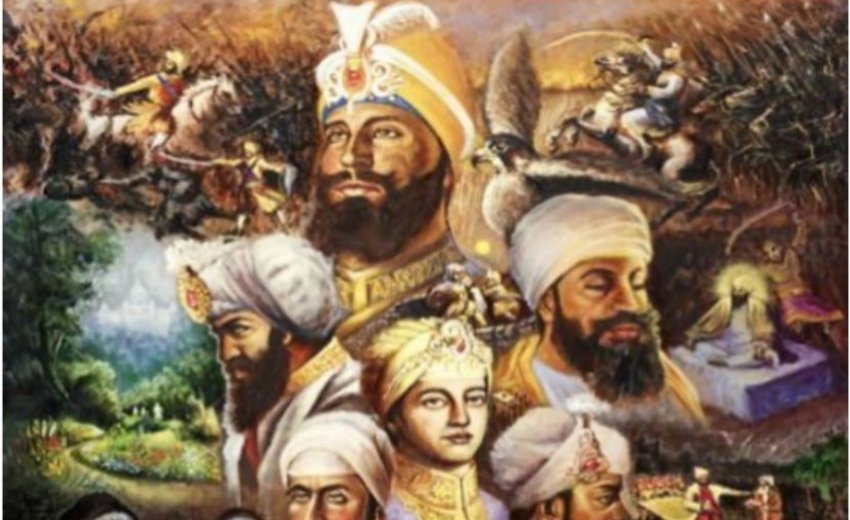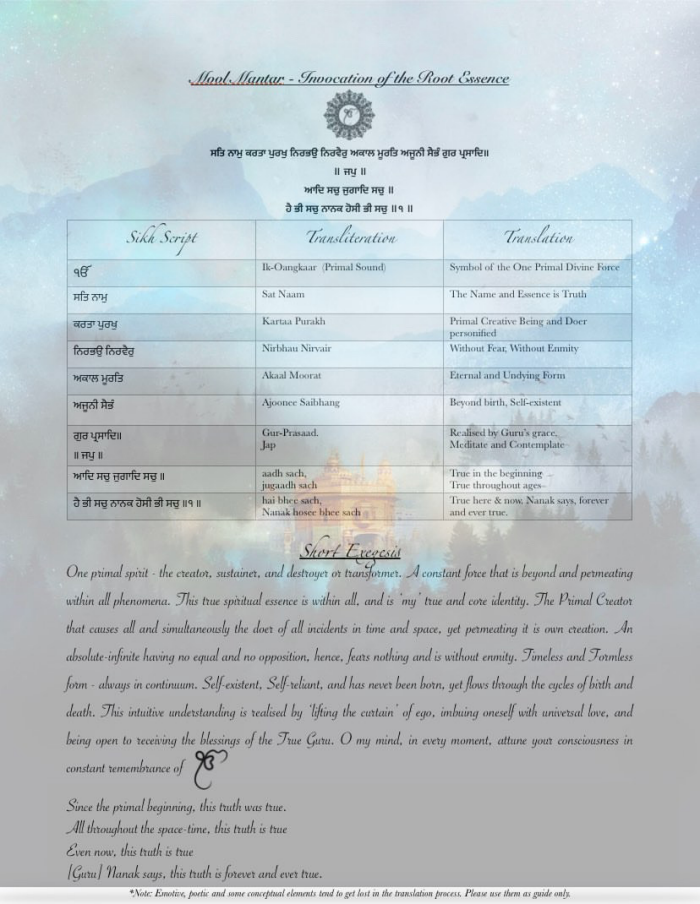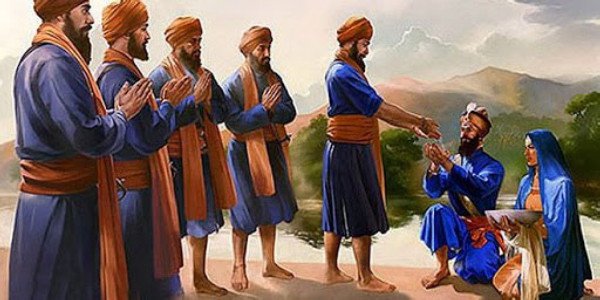Origin and Context
The word Sikh translated in English means ‘seeker of truth or a constant learner’ and has approximately 27 millions adherents worldwide.
The term ‘religion’ in Sikh context is generally used loosely as an equivalent term is not found in the in Sikh lexicon. Rather the self-defined term is Dharma, a word with multi-layered meaning but is best translated as ‘path of righteousness and moral order backed by spiritual philosophy’. Hence, belief and faith are not central but ancillaries of moral action and spiritual experience — the 2 wings of Sikh Dharma.
Sikhs call their panentheistic religion Sikhi which has a dual noun and verb meaning attached to it, and not Sikhism, a colonial-British term that doesn’t carry the native connotation. The organised order within Sikhi, joined by those who have progressed and maintained the Sikh spiritual discipline, is the Khalsa community — the collective embodiment of the Sikh Gurus formed in 1699 AD.
The origins of Sikhi dates back 550 years ago in Punjab, which is located in northwestern region of South Asia currently partitioned between India and Pakistan. This geographic area is home to the Indus Valley civilisation, and has been touched by all the major historical civilisations of east and west that have left their imprint to the region. Majority of modern day Sikhs reside at the Indian side of the border with its diaspora, making up 10% of the total Sikh population, spread across the globe.
Founding Fathers (Gurus)
The word Guru in the Sikh context means ‘enlightener’. Guru Nānak, born in 1469 and the founder of Sikh Dharma, witnessed the social inequities, empty ritualism, superstitions, blind faith, pointless asceticism, pretentious displays of purity, and religious hypocrisies around him from a young age. He was well versed in the pre-existing religious doctrines of the time and upon receiving a divine calling, he traveled extensively (as shown below) and interacted with people of all walks of life to spread his teachings, engage with saints of other traditions, and to seek community of enlightened saints that aligned with his spiritual conception. After 2 decade-long journey, Guru Nānak returns back to Punjab to set up his own community from ground up.
He taught about a single primal divine force that is not separate from the world and watching from a distance, but fully present in every aspect of creation. He therefore asserted that all humans, by virtue of their capacity to intuitively realise and experience this primordial and eternal truth, are equally touched by the divine and therefore deserve to be viewed as such regardless of gender, race, creed, class and caste. Essentially, any human being has the capacity for truthful living by living in accordance with realisation of the higher Self.
“Realisation of Truth is higher than all else, but higher still is truthful living.” – Guru Nānak
To carry forward their vision, Guru Nanak and the successive 9 Gurus created various institutions, engaged and encouraged ethical, philosophical, and spiritual discourse, and lead by example by living and sacrificing for the universal values and primal wisdom they espoused. The human-form of Sikh Gurus existed over the span of 200 years. During this period, the Sikh Gurus nurtured the nascent community and prepared the scripture by writing, compiling, and sealing it themselves.
The Sikh Scripture
The Sikh sacred scripture is called the Guru Granth Sahib, which means ‘The Revered Primal Text-Guru’. The anthology consists of 1430 pages and is divided by music, rendered poetically, with various genres, and usually supplemented by classical musical instruments to punctuate the emotional tone of the message conveyed. The Guru Granth Sahib, in so far as one engages with it in prescribed context, influences the person from within and diagnoses the deeper inclinations of behavior with positive reinforcement. Hence, the poetic expression of deep and primal wisdom instills ethical behavior rather than being rule-centric. The scripture is not concerned with political theories, and neither does it infringe upon scientific endeavors.
It also includes some hymns written by earlier Saints in whom the Gurus recognised as kindred spirits; and some of these contributors to the Guru Granth Sahib were learned Hindus and Muslims. Their writings have found a place in the Guru Granth Sahib because the Gurus held, and surely with good reason, that they were enlightened. These Saints addressed the dogmatism and deficiencies in their religious traditions, yet emphasized the universal spiritual truths contained in them. They considered the religious truth/wisdom to be highlighted in different degrees but is not exclusive to one tradition and belong to all ages, to all faiths, and is mankind’s common spiritual treasure. Thus, Sikhs accept the truths found in all spiritual and religious domain but ultimately follow its own discipline and spiritual conception.
In 1708, before passing away, the 10th and last human Guru – Guru Gobind Singh officially lifted the completed anthology to a status of ‘Guru’ to form as guide for not only the Sikhs but for all humans. Sikhs don’t view the scripture as a book or text in a normal sense of the word, but attach a very high degree of sacred meaning to it as it’s the culmination of the Gurus’ own work and incredible sacrifice, and thus their spirit in the form of poetic verses residing in it. The profound impact among the lives of many affords it the deeply symbolic title of ‘Living and Eternal Guru’.
The Sikh way does not favour zealous conversion campaigns, but allows people to ‘walk the path’ according to their own accord and will. The focus is on ongoing and evolving spiritual and philosophical education and discourse with reference to the Guru Granth Sahib, the lives and ancillary writings of Gurus and prominent Sikhs; and this is done so in wide ranging contexts.
The Sikh community holds the Guru Granth Sahib with the highest reverence and treat it as such accordingly. As such, there is no formal hierarchy of priests in Sikhi. Sikhs are encouraged to engage with the Guru without intermediaries, but can seek help from learned Sikhs called Gyanis (Intellectuals), Parcharaks (Expounders), and draw inspiration from Sikhs (or non-Sikhs) who put the virtues into practice extraordinarily.
The Gurdwara
The Sikh ‘temple’ is called the Gur-dwara – which translates to the ‘Guru’s door or gateway that leads to the Guru’. It is the place where The Guru Granth Sahib is placed on high palanquin under a canopy in the middle of one end of the hall and is recited or sung, with explanation and discourse also conducted.
The most prominent Gurdwara for Sikhs is the Harmandir Sahib, colloquially known as the Golden Temple (see image below) built by the 5th Guru (Guru Arjan) in Amritsar — a holy-city for Sikhs that was founded by the 3rd Guru (Guru Amar Das). The architecture of the Gurdwara complex conveys the values of openness as it has 4 entrance from each side to symbolise that anyone is welcome to meditate, discuss, and practice the wisdom instilled in the scripture and tradition. Most Gurdwaras in the western world have live English translations of the scripture.
All Gurdwaras in the world serve free meal to people of all backgrounds and is run by volunteers who practice Seva or ‘selfless service’ – one of the core principles of the faith. Seva doesn’t just mean serving others, but serving to develop a deep intuition of recognizing that there is no “other” in essence and the separation is merely superficial. It is a natural consequence of understanding the Universe (other) and the Self as an all encompassing conscious singularity. This tradition is called langar and it was set up by the first Guru at age of 12. Since then, the institution of Langar has been going non-stop and the largest langar is run in the Golden Temple complex serving 100,000 free meals daily. Gurdwaras also becomes a refuge center during crisis times.
Conception of Life, the Self and ‘God’
“If you want to find the secrets of the universe, think in terms of energy, frequency and vibration.” – Nikola Tesla
The unstruck [primal] sound vibrates, as it dwells within the home of [deeper] Self – Guru Amar Das
Prominent Mystics and Scientists have often theorised that the origin or secret of the universe lies in vibration, sound, and frequency. Sikhi lays emphasis on Ėk nūr te sab jag upjiā meaning “From the One Light, the entire universe welled up”, intuitively alluding to the modern idea of Singularity and The Big Bang Theory.
“Religion and science go together. As I’ve said before, science without religion is lame and religion without science is blind. They are interdependent and have a common goal — the search for truth.” — Albert Einstein
It is important to note that the terminology and conception of God with its connotations derived from Abrahamic traditions does not exist in Sikh Dharma, hence, the term ‘God’ is therefore used loosely when understanding it from a Sikh context. God as a whole is ultimately incomprehensible by the human mind’s logical faculties and strictly empirical exercise being limited by its 5 senses. Therefore, the word we use for God can only be a pointer or one of countless virtues of God rather than an all-encompassing final empirical definition. The widely used term in Sikhi is Wahe-Guru, meaning ‘Wow-Guru’ which is more a devotional expression than a definition. Sikh place their faith in the Guru to guide them in developing a deep intuitive experience of God by eliminating the sense of ‘I-ness’ called Haumai/Ego to conquer the lower base passions of the mind (5 thieves — corrupted lust, rage, unhealthy transitory attachment, greed, excessive pride), and to meditate and imbibe the divine virtues of truth, compassion, contentment, humility and love, as perfectly displayed by all Sikh Gurus in their lives and poetically written in the Guru Granth Sahib.
“Indeed, it is not intellect, but intuition which advances humanity. Intuition tells man his purpose in this life.” - Albert Einstein
The message of the Guru inscribed within the Guru Granth Sahib is conveyed in various predefined rhythm and frequency called Raags. With this, the Guru uses themes and emotions that all humans can relate to such as love, devotion, pain, ambition, hope, friendship, desire, determination, ego, duty, liberation, regret, faith, and sadness. Unlike texts of other great religions, the essence of spiritual philosophy is not conveyed with mythological narratives (although various mythologies are addressed), but in poetic verses that introspectively speaks to the minds of humans. These are then put in context with the conceptual pillar of Sikh spiritual philosophy.
This conceptual pillar is summarised by the root symbol of Sikhi -ੴ, verbally expressed as Ik(੧)-Oangkaar(ਓ). In concise terms, this means — ‘from the Timeless One [Ik] emanates the limitless and ongoing vibration of [Ooang] constantly expanding into creation [Kaar], and the One [IK] permeates creation in absolute sense whilst simultaneously transcending it.’. This root symbol is expounded on by the Mool Mantar or ‘Root Invocation’ being the opening line of Guru Granth Sahib, and is then further expanded on to make up the rest of the Sikh scripture. The succinct summary is shown in the image below.
“All perceptible matter comes from a primary substance, or tenuity beyond conception, filling all space, the Akasha or luminiferous ether, which is acted upon by the life giving ‘Prana’ or creative force, calling into existence, in never ending cycles, all things and phenomena.” – Nikola Tesla, Man’s Greatest Achievement, 1907
Music acts as a bridge for the mind to communicate with our deeper Self (soul/conscience), and it’s relationship with the primal One, with an aim to intuitively realise and more importantly experience our oneness with this higher consciousness (God – ੴ), and hence all material and non-material phenomena. In essence, God is not a separate and foreign entity to be believed in and met after death, but an ever-present Being that our soul can intuitively realise, experience and merge with in this incredibly rare opportunity of human experience.
“The supreme task of the physicist is to arrive at those universal elementary laws from which the cosmos can be built up by pure deduction. There is no logical path to these laws; only intuition, resting on sympathetic understanding of experience, can reach them.” - Albert Einstein
The Sikh tradition has the concept of 10th gate (on top of our head), similar to ‘the third eye’ as described by other traditions as a symbolic way of referring to it as the spiritual center of humans and to highlight the limitation of 5 human senses to access this deeper level of permanent consciousness. Therefore, emphasis lies in intuitive experience and Sikh music (Kirtan) is used as a primary tool ‘open the 10th gate’ to shed the ego.
The music of the praanic [creative life force] wind is deep within. The Lord of the universe plays this music, and so does it vibrate and resound – Guru Raam Das Ji
Despite recognising the temporary aspect of all phenomenon or that which can be discovered by human senses and the objective mind, Sikh tradition does not believe in living an ascetic lifestyle or to put this in modern context – subscribing to a detached form of spirituality whilst ignoring or minimising the material (scientific) and social reality (identity, family, community, and institutions). Instead, owing to the conceptual pillar of ‘oneness’ and practice of spiritual discipline, Sikhs believe in the ideal of being fully engaged with society and to take part in transforming it for the better.
The Sikh Identity & Community
In 1675, the 9th Guru sacrificed his life for the principle of freedom of conscience. Many Sikhs who were present when he was martyred denied that they were Sikhs. Their physical fear of death had made them forget their spiritual commitment to live without fear. Upon learning this, The 10th Guru vowed to imbibe an integrated martial-saint psyche to the Sikhs and give them unique identity so they would stay faithful. In 1699 he tested his Sikhs to see who would follow his path even if it meant death. The collective of committed Sikhs who passed the test were given the status of Guru Khalsa, the Guru’s own body and collective human successor. All Khalsa (men and women) are ordered to stand out wear a distinct appearance backed by spiritual and moral discipline. The men are given the middle name Singh, meaning Lion, and women are given Kaur, meaning Lioness. Gender equality has been a core part of Sikhi since inception, with women leading the congregation in spiritual preaching, leadership and even warfare.
“From woman, man is born; within woman, man is conceived; to a woman he is engaged and married. Woman becomes his friend; through woman, the future generations come. When his woman dies, he seeks another woman; to woman he is bound. So why call her bad from whom kings are born. From woman, woman is born; without woman, there would be no one at all. Only the Formless Creator is without a woman.” – Guru Nānak
It is an ideal for every Sikh to become a member of the Khalsa by taking a voluntary initiation ceremony (kind of similar concept to the Christian Baptism, but not mandatory to be considered a Sikh). One does not need to convert to follow Sikh spiritual philosophy, unless they wish to join the more disciplined Khalsa community. It’s also important to note that there are also other various communities representing diverse schools of thought within the Sikh fold.
As it has always been the case, not all Sikhs are initiated into the Khalsa, however, there are many faithful who maintain the most visible markers of a Sikh and this is regarded as progress towards initiation. For men, this is uncut scalp hair, beard, and the turban. For women, this is uncut scalp hair and an optional female-turban. There are also many Sikhs that do not embody the physical markers but follow the spiritual philosophy.
A member of the Khalsa lives in the physical image of the Guru and can be identified by the 5 articles of faith (5 Ks) gifted by the 10th Guru. As times change, some of these articles continue to undergo stylistic and material changes without sacrificing key spiritual principles that psychologically connects Sikhs to their community and history. These principles are derived from the core philosophy called Miri-Piri, being synthesis of spiritual and temporal realms with the highest virtues and principles as an ideal. To use a simple analogy, the internal software should be synthesized with the external hardware for proper functioning. Hence, the 5 articles of faith detailed below also takes on a dual spiritual-secular meaning.
- The uncut hair (Kesh) in addition to being the main identity marker, is considered a tribute to spiritually enlightened people who were/are likely to maintain uncut hair and therefore signifies spiritual wisdom and strength. Many Sikhs also see this as an acceptance of the natural order and God-given form that serves a biological function when in tact and the weakened hair falls out on its own or by grooming. Medical treatment due to hormonal imbalance is deemed to be acceptable. Ancillary to this is the turban (Dastaar), a head-dress traditionally worn by various cultures for different reasons, and was especially donned by the Indian royalty. Since the Gurus also wore this, this insignia was passed on to the oppressed Sikhs to imbibe the values of sovereignty and freedom, and for practical consideration of maintaining the uncut hair. The spiritual meaning comes from the prefix Dast or ‘hand’ and connotes having the hand of God on our head or the spiritual center (the 10th gate). Sikhs have developed a set of unique styles of turban and the style worn is based on personal preference.
- The comb (Kanga) article of faith supplements the hair to signify order, cleanliness, and active involvement in society. This is usually a small but usable wooden comb that’s tucked inside the turban and has been prescribed to use at least twice a day. This is to be seen in contrast to and in rejection of Indian ascetics who have had their heads shaved or hairs matted to signify monasticism, withdrawal or asceticism, a dominant theme in Hinduism.
- The undergarment (Kacherra) is worn for comfort, preparedness, mobility, and modesty. It is required for an active/martial lifestyle whilst being modest to steer clear from corrupt lustful behavior. In modern times, any undergarment that meets the 4 principle criteria mentioned above is considered a Kacherra. Putting this in 16th century historical context, secure underwear weren't usually worn by lower castes of India, and this would provide dignity to those who joined the ranks of the Khalsa.
- The wrought-iron circular bracelet (Karra) symbolizes the Timeless One that has no beginning and ending and hence an unbreakable attachment to God. This also acts as a reminder to use our hands truthfully in any endeavor. Historically, a thicker version was used as a knuckle duster for self-defense and sheath in sword fights.
- The dagger (Kirpaan), means “weapon of defense” (‘Kirpa’ means mercy and ‘Aan’ means honour). It is backed by historical precedent of disciplined and ethical use, and strict preventative religious sanctions. It is concealed and strictly not an offensive weapon but carries with it the principle to only use as an absolute last resort (physical threat to life and conscience). It symbolizes the everlasting duty of the Khalsa Sikhs to stand up against injustice and tyranny, and to uphold the virtue of ethical self-defense. Without this religious and historical context, it is apt for it to be misunderstood as a conventional knife, which is not the case. This is usually a small 8 cm size dagger and is strapped inside an upper-body garment. A ceremonial blunt version (less lethal than a pen or scissors) is also provided to all minors and dependents, and for adults in jurisdictions where it is currently unauthorized due to it’s contextual significance not always being appreciated.
“When all means for solving a conflict or problem are exhausted, only then placing your hand to the sword[weapon] is legitimate.” ― Guru Gobind Singh
The 5 articles of faith are inseparable ancillaries to the internal spiritual philosophy and contributes to uplifting the consciousness of the Khalsa Sikhs regardless of their status, and is also an equaliser. It is important to note that wearing the external form without the pursuit of constantly developing the internal virtues and principles render the articles of faith meaningless for Sikhs. They are worn with deep sense of responsibility given that countless Sikhs were martyred to maintain this identity and the universal values it represents. Although Sikh values are not unique or exclusive to the Sikh tradition, with most being shared across various faiths and cultural traditions, the context and expression of these values are provided by the unique first principles and the history of the community which supplements and defines its identity. This context and expression of universal values are derived from a distinct metaphysical and philosophical conception.
In the western world, almost all individuals you will see wearing the turban are Sikhs.
List of some prominent Sikhs in modern era
Harjit Singh Sajjan – Defence Minister of Canada
Narinder Singh Kapany – Inventor of Fibre Optics Cable
Piara Singh Gill – Pioneer in cosmic ray nuclear physics and worked on the American Manhattan project.
Jagmeet Singh – Leader of a Canadian Political Party (NDP)
Ajay Singh Banga – CEO of MasterCard
Gurbir Grewal – 61st Attorney General of the State of New Jersey
Dalip Singh Saud – The first American of Asian descent elected in US Congress
Dharma Singh Khalsa – an American physician and prominent medical researcher in the field of Alzheimer’s Disease.







